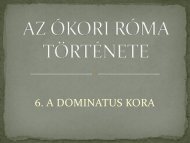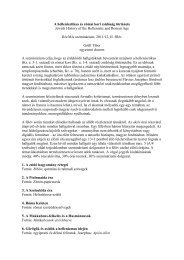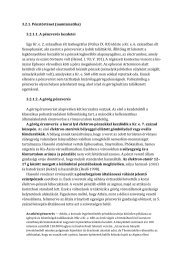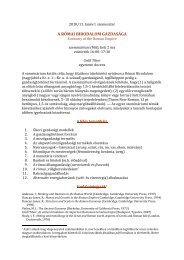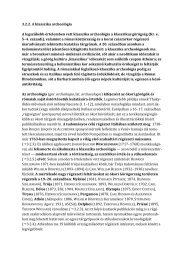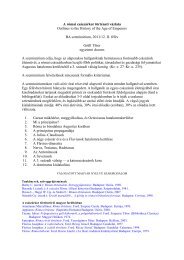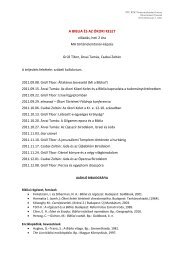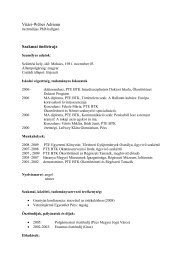A Boleráz, Baden és Kostolac kultúrák kronológiai és térbeli ...
A Boleráz, Baden és Kostolac kultúrák kronológiai és térbeli ...
A Boleráz, Baden és Kostolac kultúrák kronológiai és térbeli ...
You also want an ePaper? Increase the reach of your titles
YUMPU automatically turns print PDFs into web optimized ePapers that Google loves.
geographical centers are often do not coincide with the social or economic centers, as it was<br />
demonstrated on the example of 16 th century Spain by I. Wallerstein).<br />
One of the problems is that no uptodate site-cadaster is obtainable, not even in<br />
relation with the <strong>Boleráz</strong>/<strong>Baden</strong> culture, moreover majority of the excavated material have<br />
not been published for the international and domestic research.<br />
I made an attempt to collect <strong>Baden</strong> from, and summarize the main characteristics of<br />
the sites the Hungarian territories:<br />
- The network of the settlements seems to be dense, but this may be misleading: it is not sure<br />
that it depicts a same scale population increase. As compared to the Middle Copper Age, the<br />
growth in the number of settlements can be explained by the fact that most of the settlements<br />
are temporal/seasonal camps, connected to the adjusted lifestyle of the <strong>Baden</strong> population<br />
(wetland nomadic; 11 large-scale animal husbandry: semi-sedentary, semi-nomad).<br />
- Most of the sites are located on hills near water. Significant part of them is temporal, smallsized,<br />
but there are large, central, permanent, long-lived settlements as well.<br />
- The extramural cemeteries are the burial sites of more communities, as graveyards show<br />
more fixed character, than the greater part of the sites (1. Attachment). 12<br />
The deficiences of Hungarian research can be summarized as the following:<br />
- In case of topographically localized and archaeologically excavated settlements, in best case<br />
only the slightest portion became unearthed (no attempt to do fieldwalking or sondage<br />
excavation). Thus, no information is available on the inner structure, and the spatial<br />
expansion of the settlement. Few facts are revealed about the relation of settlements and the<br />
connection to their cemeteries.<br />
- Only the selected part of the unearthed material is published. In my opinion, the research<br />
loses too much energy on the selection of insignificant material from the total find horizont,<br />
in particular typology. The typological figures, which are eve unacceptable as estimation, are<br />
used to calculate ratios, and upon this haphazard conglomerate of information far-reaching<br />
theories are written on the inner periodization and cultural connections of the site. At the<br />
same time, we don’t know physically those finds we want to connect the excavated material<br />
(such as the effect of Cernavodă III sites, or the CoŃofeni-impact, which should be rightly<br />
revised together with scholars, who are exactly the experts of the cited cultures). Excately,<br />
the pottery is the find-type, where typology or production techniques are hardly detectable<br />
from publication, and may cause great troubles. Most of the publications struggle with bad<br />
quality figures, lack of space and the ceramic-fragments are completed incorrectly,<br />
individualistically, and the drawing do not contain basic details (such as colour, surfacestructure,<br />
profile, scale). Further on, in the descriptions, wher all these lacking illustrative<br />
information could be compensated, due to lack of space or intention these data are also<br />
missing: what tempering agent was added, the firing, how the vessel was produced. And if<br />
would not be so, the illustrative picture of the object is far from the physical reality.<br />
In relation with the dating of the culture, the following potential modifications are recommended:<br />
- The material of the Protoboleráz IA phase and the <strong>Boleráz</strong> IB phase separated by unstable<br />
typological analyzes cannot be divided on the basis of radiocarbon dates separated. Thus, it<br />
is not crucial that the two groups should be distincted. The developing phase of the <strong>Boleráz</strong><br />
in my opinion is more objectively indicated by the <strong>Boleráz</strong> pottery mixed with the Middle<br />
Copper Age cultures, such as the Ludanice, Balaton-Lasinja, Furchenstich ceramics.<br />
- The influence of the Cernavodă III culture cannot be taken into account, since the cultural<br />
entities were connected only in the post-<strong>Boleráz</strong> phase. It is more possible that the <strong>Boleráz</strong><br />
11 FIGLER et al. 1997.<br />
12 The site-cadaster of the <strong>Baden</strong> sites is also available on the internet: www.archeo.mta.hu/staff/Horváth<br />
Tünde/conference/publications/MΩMOΣ VI, Kıszeg. The data was collected up to 2009.<br />
4




